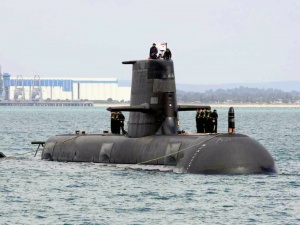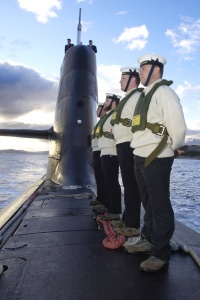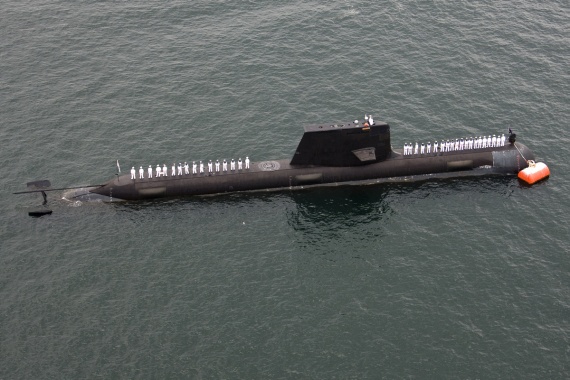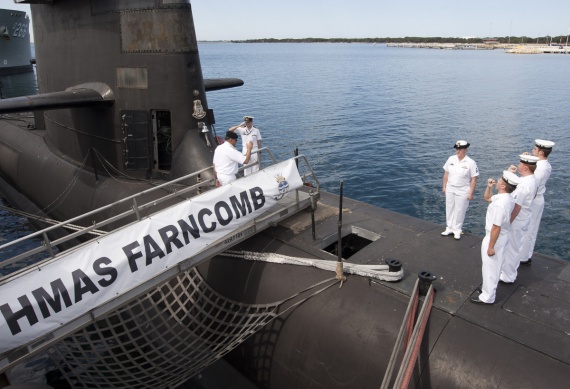HMAS Farncomb
| Class |
Collins Class |
|---|---|
| Type | |
| Pennant |
S74 |
| International Callsign |
VMLF |
| Motto |
With Skill And Resolve |
| Home Port | |
| Builder |
Australian Submarine Corp, Adelaide |
| Laid Down |
1 March 1991 |
| Launched |
15 December 1995 |
| Launched by |
Mrs Jean Farncomb (widow of Rear Admiral Harold Farncomb) |
| Commissioned |
31 January 1998 |
| Dimensions & Displacement | |
| Displacement |
|
| Length | 77.8 metres |
| Beam | 7.8 metres |
| Draught | 7 metres |
| Performance | |
| Speed |
|
| Range | 11,500 nautical miles |
| Complement | |
| Crew |
|
| Propulsion | |
| Machinery |
|
| Armament | |
| Missiles | McDonnell Douglas Sub Harpoon Block 1B (UGM 84C); active radar homing |
| Torpedoes | 6-21 in (533 mm) fwd tubes. Gould Mk 48 Mod 4/6/7; dual purpose; wire-guided; active/passive homing |
| Mines | 44 in lieu of torpedoes. |
| Physical Countermeasures | Decoys: 2 SSE. |
| Electronic Countermeasures | ESM: ES-3701U; intercept and warning. |
| Radars | Navigation: Kelvin Hughes Type 1007; I-band. |
| Sonars |
|
| Weapon Control Systems | AN-BYG 1. Link 11 |
| Resources | |
| News Articles | |
| Image Gallery | |

Based at Fleet Base West in Western Australia, HMAS Farncomb was the second of the six Collins Class submarines to enter service in the Royal Australian Navy. These submarines are a formidable element in Australia's defence capability.
Farncomb was launched in Adelaide, South Australia by Mrs Jean Farncomb (Rear Admiral Harold Farncomb's widow) on 15 December 1995 and commissioned in Fremantle, Western Australia on 31 January 1998.
Farncomb's operational characteristics and range have been tailored specifically for its defence and two-ocean surveillance role in the Royal Australian Navy. Designed to be as quiet as advanced technology can achieve, Collins Class submarines have been developed from five generations of submarines designed and built by the Swedish Navy.
One of the first submarines to be totally designed by computers, Farncomb boasts a vast range of features. They include a high-performance hull form, highly automated controls, low indiscretion rates, high shock resistance, optimal noise suppression and an efficient weapons handling and discharge system.
The submarine moves silently on electric power supplied to the propulsion motor by banks of new technology lead-free batteries. The batteries are charged by three onboard diesel generator sets.
The sophisticated combat system gathers its intelligence from its sensors, computes the input and then launches and directs weapons.
HMAS Farncomb has successfully conducted a range of activities throughout the region in support of Australian Defence Force exercises, operations and the government's strategic directives.
HMAS Farncomb is named after Rear Admiral Harold B. Farncomb CB, DSO, MVO, RAN who distinguished himself in action during World War II. He commanded HMAS Canberra (I) in 1941 when the ship forced two German raider support ships to scuttle while on Indian Ocean patrol. Later, aboard HMAS Australia (II) he saw action in the Coral Sea, Guadalcanal, the East Solomons, Arawe and Cape Gloucester. He assumed temporary command of His Majesty's Australian Squadron when Commodore Collins was wounded aboard the HMAS Australia (II) at Leyte in 1944. He commanded the Squadron in operations at Corregidor, Brunei and Balikpapan.
History of The Crest
The Blazon
Per fess azure and argent; fess wavy of two argent and azure, in chief a seven pointed star and in base, a swan rampant, wings elevated, sable, beaked and legged gules, gorged with a naval crown or, in fess point two swords of justice in saltire, points upward, hilted or, proper.
Motif Description
The field colourings of blue and white represent the Navy and the sea. The seven pointed star and the heraldic black swan are derived respectively from the HMAS Australia and HMAS Perth badges in which Farncomb served with distinction. The crossed Swords of Justice represent the practice of law by Farncomb after his retirement from the Navy.







